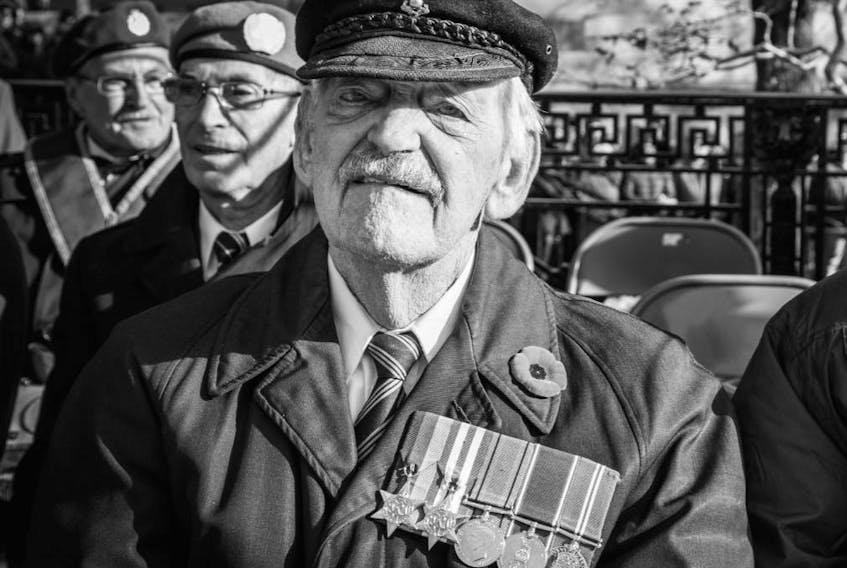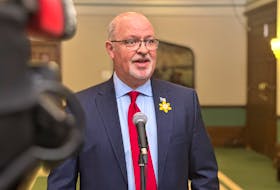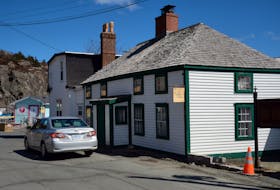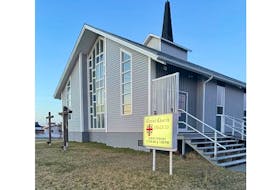When Leo Knox set out for the Remembrance Day ceremony at the National War Memorial in St. John’s last Nov. 11, he was gravely ill, but as he was known to do through life, he put his own troubles aside to honour his comrades.
“He put on such a brave face. … He was dying at the time and he sat in the cold. It is just such a big loss,” his daughter, Brenda Beitenman, of St. John’s said Thursday, a catch in her voice over her father’s passing this week.
The gunner had been one of the Newfoundland and Labrador’s last surviving members of the 166th (Newfoundland) Field Regiment, Royal Artillery.
The 93-year-old — who would have celebrated his 94th birthday Thursday — died at the Dr. L.A. Miller Centre in St. John’s Monday.
Besides being a veteran, Knox was a retired St. John’s firefighter credited with being instrumental in the development of a fire prevention program.
When he took his family on summer vacation, camping and visiting communities all over the island, he would bring along film reels and review fire prevention plans at hospitals, nursing homes, schools and other facilities, and lecture on fire prevention while his family relaxed.
“That speaks to the kind of man he was. He was dedicated to fire safety in this province,” his son, Pat, of Calgary, said after hearing the vacation story from his younger sister, Kathleen.
Knox also lugged that bulky equipment of decades ago on and off buses around metro to spread the word in those early days.
St. John’s Regional Fire Department Chief Sherry Colford said Knox was the department’s first fire prevention officer when it started in 1968 and was the person who served the longest in that role in the history of the fire department.
Colford said there were no vehicles then for such work, hence Knox having to haul equipment on and off city buses to get around and get his message out and to do inspections.
“He developed fire safety for schools, businesses — he was a mentor to the new firefighters coming up through and would take them out on inspections,” Colford said.
What Knox was instrumental in developing has evolved over the years into the department’s current initiative — the Learn Not to Burn program.
Prior to his early efforts, there was an emphasis on fighting fires, but not on teaching people how to prevent them from starting.
At the time, the fire department was with the province, so Knox spread his fire prevention messages to all communities.
He was also instrumental in developing fire safety for nursing homes, especially after the Chafe’s Nursing Home fire in the Goulds in 1976, which killed 21 people.
Colford said Knox — who joined the fire department in 1952 and retired in 1983 — had the reputation among former colleagues as being “well respected, compassionate and kind. He had a vested interest in the public and promoting fire safety.”
Meanwhile, Knox spoke little of his war experiences during his lifetime, preferring to move on with life, Brenda said.
Pat Knox said he came home to be with his father about a month prior to his death, and suddenly one day at breakfast he was shocked when Knox opened up about some of the carnage and other destruction he had seen while a dispatch rider carrying information to the Front and back.
“I never (before) heard my father talk about that,” Pat Knox said. “I feel like he just wanted to share with me some of the history.
“We can only imagine. Those of us who didn’t serve in war to fight for our freedoms, we have no idea what those young men and women went through.”
During his time with the fire department after the war, Knox saved lives, but saw a lot of devastation as well.
“He handled everything with dignity, respected everybody, always put his own personal feelings aside,” said Beitenman. “He carried on for everybody else and never complained. … He was a strong man to the end."
Beitenman said he was always able to find humour in everything, and she believes that had a large impact on his ability to get through tough times in war, firefighting and other life struggles. He also drew his strength from his great love for his family and his wife of 75 years, Mary.
“He loved her beyond everything. They weathered the storm,” Beitenman said.
“Mom is the same — a very strong-willed person. Everything they have, they worked for.”
Both Pat Knox and Beitenman spoke of their father having saved two children from a fire and how the children’s father — a restaurant owner — would insist that he never pay for a meal if Knox and his family went to the business. But Knox was embarrassed and so stopped going there, as he didn’t want to take anything from the man’s livelihood.
Knox enlisted with the 166th as a teenager, joining the 166th in Italy in 1944. Pat Knox said the story recounted was that his father lied so much about his age to try to get in, the recruitment centre just gave up and took him.
Upon his return from active service, Knox was working for a construction company and was sent to the old Central Fire Station on Parade Street in St. John’s to install a set of rolling doors, and removed the old ones set in the heavy pillars by himself. He so impressed officials, he decided to apply for a job there, according to Pat Knox.
He went on to serve 35 years with the St. John’s Regional Fire Department and largely educated himself in fire prevention, his son said, explaining that his father had to quit school early on when his mother died young, and had to help look after the large family left behind.
After retirement, he travelled with his wife and took her to see where he fought in Europe.
Knox developed prostate cancer about a year and a half ago, and about 10 months ago it spread to his bones, his son said.
But when it came to Remembrance Day, it was the respect for his fallen comrades — as well as veterans who survived the war, but have since died, and those who remain — that kept him going to the ceremony, no matter what his health troubles were.
“This last one, he struggled, but he said, ‘No, I need to get there,’” said Pat Knox, also breaking with emotion during a phone interview.
“So, he sucked it up, being the man he was, and made his way down.”
Beitenman said his family intends to continue the Remembrance Day practice in their father’s honour.
Knox was a member of the Royal Canadian Legion for 71 years and proudly carried the regimental colours to the Basilica to have them blessed.
A news release from the Legion’s Newfoundland and Labrador command said Knox “will be fondly remembered as a hero and a gentleman.”
Knox leaves to mourn Mary, his other three children: Stephanie, Greta and Rod; 15 grandchildren, 26 great-grandchildren, and one great-great-grandchild.
His funeral is at Barrett’s Funeral Home today.









